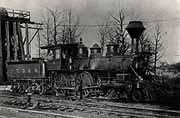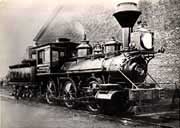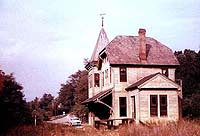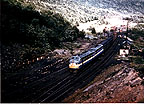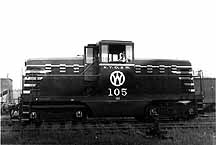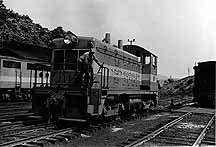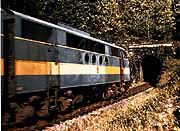The New York, Ontario and Western Railway started out as the New York and Oswego Midland Railroad, running from Oswego on Lake Ontario southeast to the New Jersey border at Unionville, where the New Jersey Midland Railroad continued to Jersey City. After the reorganization in 1880 of the New York and Oswego Midland (and the New Jersey Midland), the newly-organized New York, Ontario and Western built a new route in New York, from the old route at Middletown east to Cornwall on the Hudson River. The opening of the West Shore in 1884 gave the New York, Ontario and Western trackage rights from Cornwall south to Weehawken, which it kept through the reorganization and buyout by the New York Central.
The New York & Oswego Midland Railroad, the O&W's predecessor, was the grandiose vision of Dewitt C. Littlejohn, a dynamic politician bearing an uncanny resemblance to Abraham Lincoln. His concept of a direct rail route northwest across New York State, serving virgin territory not reached by any existing line, seemed logical.Thus in 1868 the "Midland" began building, meandering this way and that to reach the towns which had put up money for its construction. Its twisting route was built "at right angles to the mountains" requiring steep grades, high bridges and enormous fills. Construction costs far exceeded estimates, and within a month of completion the Midland was bankrupt. But it survived, and was reorganized in 1880 as the New York, Ontario & Western Railway.
Shortly after the O&W was incorporated, its owners became involved in the promotion and construction of the New York, West Shore & Buffalo, a route that eventually would parallel Cornelius Vanderbuilt's New York Central & Hudson River all the way to Buffalo via Albany, N.Y. Naturally, NYC&HR viewed the West Shore as a nuisance or blackmail scheme.
Complicated financial arrangements existed between the O&W and the West Shore which were detrimental to the corporate health of the former. However, this was mitigated by the West Shore's construction of a branch from its main line at Cornwall, N.Y., to Middletown in 1883 and by opening terminal facilities in Weehawken, on the Hudson River across from New York City, in 1884. These projects provided the O&W with a more-reliable and more-direct route to the metropolitan area than had been available with the NJM connection. The O&W-West Shore combination was dissolved when the later entered bankruptcy in 1884 and was subsequently leased by the NYC. The Middletown Branch became part of the O&W, and NYC permitted O&W to continue using the West Shore between Cornwall and Weehawken.
The O&W underwent an administrative reorganization after its involvement with the West Shore came to an end. Thomas P. Fowler, a talented lawyer formerly with the NYC's legal department, became the new president.. He is reputed to have said that he wondered why the O&W had been built and why, after entering bankruptcy, it hadn't been allowed to stay there. Regardless of his comment, he must have seen some potential in the line, and with the American economy in a period of expansion, he set out to make a respectable property of the NYO&W.
During Fowler's term, the railroad significantly aided in, or undertook the development of, several industries. It firmly established itself as a tourist carrier to the resort hotels and camps in the mountains of Orange, Sullivan, and Delaware counties (often referred to as the "lower Catskills"). The road expanded its operations in the haulage of milk and dairy products and, most importantly, it became a carrier of anthracite coal by tapping the northern Wyoming Valley coal field in northeastern Pennsylvania through the railroad's most-ambitious expansion program: the construction in 1889-90 of the 55-mile Scranton Division.
Although the coal business wavered in the 1920's, it remained strong into the early years of the Great Depression and it permitted the O&W to continue paying dividends. Nonetheless, petroleum fuels, natural gas and electricity were making ever greater inroads into coal markets. Coal was losing ground, but it definitely was not out. O&W handled only about four percent of the anthracite shipped out of Pennsylvania, but in the early 1930's, this one commodity still accounted for over 50 percent of the railroad's income. But this was an unhealthy situation, one of too great a reliance on one industry.
The decline of coal was not O&W's only dilemma. Economic activity as a whole in the U.S. was changing dramatically. Manufacturing activities were moving to the South, Southwest and West , and the resultant population shifts were changing the consumer markets and the rural economy upon which the early O&W and its predecessors had relied.What the OM's developers had promised the railroad would do had occurred; but it was Western railroads opening Western lands to agricultural development that better filled the promise. The decline in the importance of the small towns and cities, the expansion of the suburban industrial parks, and the population shifts to metropolitan areas or to other parts of the country were severely felt by "rural roads" such as the O&W.
On Feb, 25, 1937, the O&W advised the holders of it's Refunding Mortgage Bonds, due in 1992, that it could not pay the interest due on March 1. Two of the three railroad-owned collieries had earlier defaulted on their loans from the railroad. This, coupled with an overall decease in anthracite tonnage, reduced freight rates, increased taxes and other increased expenses caused the railroad to default on its financial obligations,. As a result, O&W entered a voluntary bankruptcy from which it would not emerge.
This aerial photo of the Middletown Shops was taken to accompany the news of the O&W's bankruptcy in 1937
The following is an excerpt from our 1995 calendar:
Naming locomotives was commonplace during the 1800's. The Oswego Midland named it's locomotives after towns and counties that gave their financial support to the railroad. The first Midland locomotive built was delivered by the Rhode Island Locomotive Works in April of 1869. This 64,ooo pound 4-4-0 (appropriately numbered 1) was named "Oswego" after the road's northernmost terminus and home of the railroad's President, the honorable Dewitt C. Littlejohn. The "Oswego" remained in service on the O&W until October of 1887. A Rogers 4-4-0 originally delivered to the New Jersey Midland in 1870 named "Passaic" was scheduled to be renamed "Dewitt C. Littlejohn", but bankruptcy preceded this event and the locomotive was returned to the NJM in 1874.
The Midland's locomotive roster (between 1869 and 1874) contained some 97 locomotives. Of these, 14 locomotives became victims of the bankruptcy, several were sold and the rest were returned to their builders or the NJM. The last Oswego Midland locomotive to be removed from service by the O&W was Rhode Island built number 95. This K class 2-6-0 named "Mountain View" was also among the last groups of locomotives delivered to the Midland in July and August of 1873. She sold to the Southern Iron and Equipment Company in August of 1918, ending 44 years of service and the end of the Midland's motive on the O&W.
( click on each photo below to view larger image )
|
|
|
Excerpts from Robert E. Mohowski's book,
"NYO&W IN The Diesel Age".
The Flying Diesel Corps
by Robert E. Mohowski
On the dark rainy night of Sept. 27, 1955 train ON-2 rumbled into Hamilton, N.Y., as it had done so many times before. Engineer Les Vidler had FT 803 on a 50-car train that night and was making about 34 mph when he--or someone else in the cab-- noticed that a mainline facing- point switch was set for a siding leading up to Leland's coal trestle. The
engineer quickly applied the brakes,but the momentum was enough to push the train up the siding, through the coal-shed doors and the barnlike structure and out the opposite end. After the noise ended and debris settled, it was found that the 213-ton locomotive had "flown" 150 feet beyond the end of the coal trestle after taking off from an elevation of 15 feet. The drawbar between the A and B units snapped, and four cars had followed the air-borne FT's. A fifth car hung off the end of the trestle. Two men in the 803's cab, Road foreman of Engines Fred Lewis and fireman Oliver Wrench, were seriously injured.
Several theories were advanced as to who threw the switch,but, so far as is known, a state police investigation did not result in any arrests. At a dinner honoring the crewmen for their skill, courage and devotion to duty, Trustee Lewis D. Freeman said that the men had been air borne for about six or seven seconds. Each crewman received a plaque and a cast model presentation F-unit courtesy of EMD. Road Foreman Lewis also got a special note advising him"...not to try this stunt again." The 803 returned to service following repairs at Middletown.
One of the cars involved in the wreck was loaded with chocolate bars from the Nestle plant in Fulton. Local people soon found out, and little if any candy was sold in Hamilton for some time. ©1994 Andover Junction Publications.


